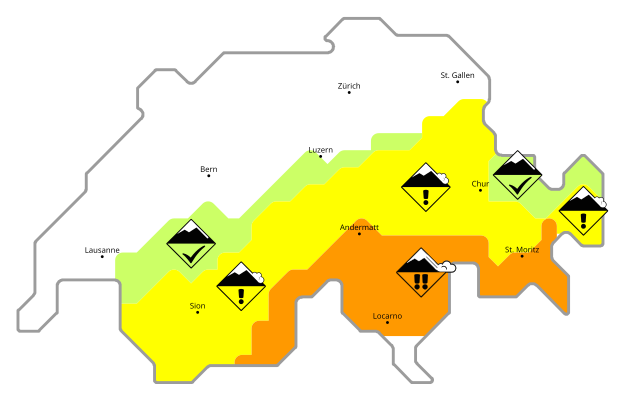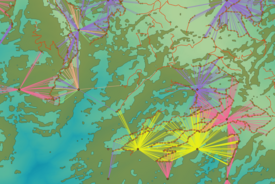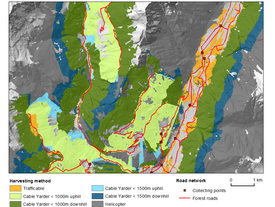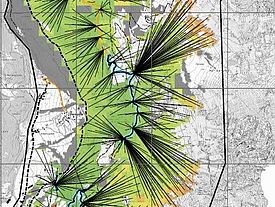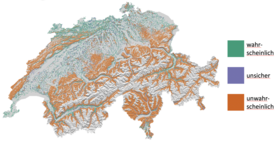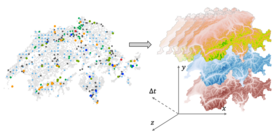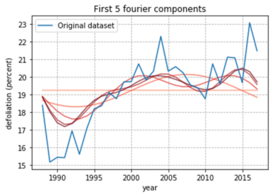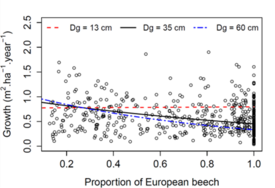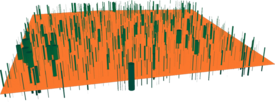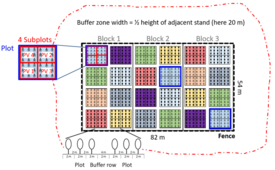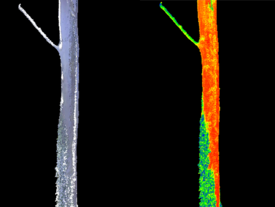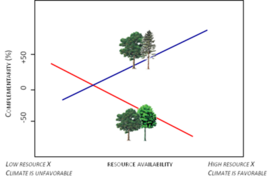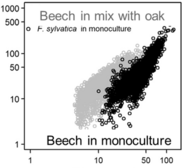Christoph Fischer - Defining near-optimal harvesting techniques using Swiss National Forest Inventory data
In Switzerland, the competitiveness of the Swiss forestry sector is currently under discussion. The cost-effectiveness could be increased through the application of up-to-date harvesting and transportation techniques The Swiss National Forest Inventory (NFI) delivers a wide range of information on forests using a combination of field assessments and interview surveys. Through the interview survey, including all local foresters of Switzerland (about 830), the Swiss NFI is one among few NFIs able to assess the currently applied harvesting technique and calculate timber harvesting costs for each field plot. Using available NFI data and derived information, we can thus contribute to the current discussion.
In order to evaluate the suitability of the currently applied harvesting techniques, we developed a method to derive the technical feasibility of a variety of potential harvesting techniques. Additionally, we also compared their transportation routes for cost estimations. To identify the technically feasible harvesting techniques we used various wall-to-wall, spatially explicit (topography, forest map), as well as field (NFI plot) data (obstacles for harvesting operations, mean DBH, species composition) and interview data (applied harvesting techniques) from the NFI.
The allocation of the optimal harvesting technique is still being implemented (work in progress) but will be done using expert-defined rules for each NFI field plot. For the allocation, the technical feasibility as well as the harvesting cost of each alternative will be taken into account. We will then compare the optimal harvesting technique with the currently implemented harvesting technique at each sample plot. The transportation cost on the forest road network will be evaluated with regard to its geometrical dimensions (e.g. road width, bearing capacity).
With our results, we hope to show that cheaper, optimised, harvesting techniques could be applied in various parts of Switzerland, thus substantially reducing costs for forest owners.
Marielle Fraefel - Analysing timber harvesting and transport options for the entire Swiss forest
Forest accessibility from an existing road network is often assessed using average values such as road densities or simple spatial descriptors such as buffers. However, these methods do not take into account the heterogeneity of the terrain or soil properties. Moreover, because both the hauling of wood to a nearby road and the on-road transport contribute to the total timber production costs, information on the whole logging process should be used to find combinations of possible harvesting techniques and transport routes. Our approach allocates the most suitable harvesting technique – cable, ground-based or aerial systems – to every forest parcel (pixel), and identifies the corresponding landings on a road. In a second step, the best transport route out of the forest is determined using the topological NFI forest road network. For each forest parcel, the corresponding harvesting and transport costs are then estimated, and the most economic harvesting technique and transport route can be found. The main result is a country-wide, 10-m-resolution map of forest accessibility, indicating the suitability for economic wood production. The model results can also be compared to the currently practised methods identified in the NFI.
Leo Bont - Optimizing the layout of an existing forest road network in steep terrain
Most existing forest road networks in Switzerland were built between the 1950s and the 1980s, so they were planned for different conditions that we find today (different harvesting and hauling technology as well different financial restriction). At latest when reaching the end of the life cycle, those road networks need to be redesigned. For example some road segments will not be required anymore, some need an upgrade and some road pieces need to be new constructed.There are few methods that consider redesigning of existing road networks. Henningson et al. 2007 presented a model for redesigning forest road networks. They considered road upgrades to reduce the losses due to road closures caused by heavy rains or thawing. As this model is hard to solve, Flisberg et al. 2014 presented an easier-to-solve implementation for this problem. But however this model is still large and hard to solve as it integrates harvest and logistic planning into the model. Integrating harvesting and logistic planning is not necessary in our case, as there are different silvicultural restrictions in the alps.Based on an existing road network, our model aims to identify a harvesting and road network layout that minimizes concurrently the cost for the road network (construction, upgrade and maintenance), the wood harvesting and the hauling operations over an entire life cycle. This is accomplished by selecting road segments that are necessary, assigning them a certain road standard, determining which parcels are to be harvested by what harvesting technology and to detect the hauling route. We require to harvest all timber parcels.We present an Mixed Integer Linear Programming Model, which was applied to optimize the road network of the entire Poschiavo Valley in the Swiss Alps. The valley was split into 7 catchments for which the optimization was done. Computation time for these areas was between few minutes up to 30 minutes, which allows also to do some sensitivity analysis. The harvesting methods were mainly cable based, the hauling was mainly done by truck, but also, as a particularity by railway.When doing such simulations, a particular attention must be paid to an accurate cost estimation of road building or upgrading, or the uncertainty must be considered trough sensitivity analysis.The results were evaluated and discussed with the forest service and road planning specialists. Results seemed to be very realistic and comprehensible. The represents of the forest service decided to consider the outcome of the project, before doing further investments in road networks.
For more Information see: Bont, L.G.; Church, R.L., (2018). Location set-covering inspired models for designing harvesting and cable road layouts. European Journal of Forest Research, 137 (6), 771-792. doi: 10.1007/s10342-018-1139-7
Bont, L.G.; Fraefel, M.; Fischer, C., (2018). A spatially explicit method to assess the economic suitability of a forest road network for timber harvest in steep terrain. Forests, 9 (4), 169 (21 pp.). doi: 10.3390/f9040169
Bont, L.G.; Heimimann, H. R.; Church, R.L., (2015). Concurrent optimization of harvesting and road network layouts under steep terrain. 232 (41), 41-64. doi: 10.1007/s10479-012-1273-4
Rafael Wüest - MoGLI – Modellierung der potentiellen Verbreitung von Gehölzarten im Schweizer Wald
Das Hauptziel dieses Projektes ist, die aktuelle Verbreitung der häufigsten Gehölzarten des Schweizer Waldes flächendeckend zu modellieren. Gute Kenntnisse zur Verbreitung von Arten in Schweizer Wäldern sind nicht nur für die Grundlagenforschung (z.B. zur Überprüfung ökologischer Theorien), sondern auch für angewandte Fragen rund um die Nutzung und den Schutz natürlicher Ressourcen wichtig. Das MoGLI-Projekt entwickelt dafür Verbreitungskarten in hoher räumlicher Auflösung (25m) und stellt sie der Forschung und Praxis zur Verfügung. Dieser Vortrag führt die verwendete Methodik ein und zeigt einige Resultate; Verbreitungskarten von Gehölzen. Der Fokus liegt dabei darauf, die Möglichkeiten und Limitierungen der erstellten Karten aufzuzeigen.
Marco Ferretti, Fabrizio Cioldi - RapiDbeeCH - Rapid survey on short-term effects of 2018 Drought on beech forests in Switzerland - CH
RapiDbeeCH is a spontaneous FOREMA Research Initiative. FOREMA field crews will (re)visit NFI plots to evaluate the impact of 2018 drought on beech forests. Besides data for ad-hoc scientific analyses, this will provide guidance for a concept on how NFI and other FOREMA infrastructures can be used for future assessment of effects of sudden, acute, adverse, extreme events on Swiss forests, also in co-ordination / co-operation with other Swiss forest monitoring programs and projects. Here, some information is provided about the way in which RapiDbeeCH was made operational.
Christoph Düggelin - Spherical images on NFI plots
In addition to the data collection, the NFI documents its sample plots using various means. This ensures e.g. the retrieval of the sample plots in future inventories or subsequent clarifications in the office are facilitated. Since the start of NFI5 in 2018, a spherical photo of each visited sample plot has been created. The camera RICOH THETA V is used to take this picture. The camera is very compact and priced at around CHF 400. The operation is via an app on the smartphone and the time required for taking a photo is about 1-2 minutes. Besides to the two possible uses already mentioned above, it would also be conceivable to use the photos by means of virtual reality glasses at the periodic interview survey with the local foresters. The camera allows versatile application possibilities with little effort and could therefore also be useful for other WSL projects.
Volodymyr Trotsiuk - Data assimilation in forest ecosystems using forest inventories and processes growth model (Preliminary results)
Data assimilation, a process of incorporating observations into a forecast model, helps to improve our understanding of forest dynamics. Existing models of forest ecosystems dynamics include large uncertainties, which ramify and lead to divergence in forecasts how climate change will impact the future terrestrial carbon cycle. To reduce these uncertainties, it is necessary to extend and combine assessments of current observation networks using novel analytical approaches and data sources.
We applied a data assimilation technique, widely used in numerical weather prediction, to estimate Swiss forest net ecosystem productivity (NEP) at monthly resolution in order to relate biomass changes over time with global drivers. In particular, we link permanently monitored sample plots data of high spatial but low temporal resolution with 3-PG (physiological processes predicting growth) model. We first conduct a Bayesian calibration to estimate a set of posterior parameter probability distribution, and then propagate the estimated uncertainty.
I will present a conceptual framework along with preliminary results aiming to establish NEP data assimilation system hoping to learn from long experience of data assimilation techniques used in numerical weather prediction. The preliminary results are based on subset of National Forest Inventory plots with dominance of Norway Spruce.
Dirk Karger - DEForScen - Understanding canopy defoliation of European forests under recent climate changes to predict future adaptation scenarios
There is increasing interest to identify patterns of current plastic and evolutionary response of plants to climate change. Since plasticity can be reflected by tree health, one possible investigation approach is the analysis of tree health (canopy defoliation) data collected on ca. 6000 plots across Europe since the 1980s and for which a fully convincing evaluation is still missing. We will investigate if changes and trends in defoliation permit to identify species-specific response to climate change, also in view of future adaptation scenarios. We will do it according to novel methods, including Fast Fourier Transforms, selection of candidate variables, grouping of sites, optimal spectra (time window) and offset (time lag) for each variable, and response in relation to predictors within moving windows.
Johannes Heinzel - Ansätze zur Schutzwaldanalyse mittels terrestrischem Laserscanning
In dieser Präsentation berichte ich über verschiedene Ansätze zur Analyse von Schutzwäldern mit Daten von terrestrischem Laserscanning (TLS). Mithilfe dieser Methoden soll im Rahmen des LFI-Projektes ‘Beurteilung von Schutzwäldern mittels Fernerkundung‘ geprüft werden, inwieweit sich die Verjüngung in Schutzwäldern automatisiert erkennen und quantifizieren lässt. Die Einzelmethoden umfassen grundlegende Techniken wie die radiometrische Korrektur der Intensität von Laserscanningsignalen sowie verschiedene Teilanwendungen. Zu letzteren gehören beispielsweise die automatisierte und dreidimensionale Isolierung von Baumstämmen aus den Gesamtdaten, die Bestimmung des BHD sowie ein Ansatz zur Erkennung von Einzelbäumen. Letztendlich wird getestet inwieweit mit Hilfe der Teilmethoden die Verjüngung auf Probeflächen ähnlich derer der Forstinventur bestimmbar ist.
For more Information see: Heinzel, J.; & Huber, M. O., 2017: Detecting tree stems from volumetric TLS data in forest environments with rich understory. Remote Sensing, 9(1), 9 (17 pp.). http://doi.org/10.3390/rs9010009
Heinzel, J.; Huber, M. O., 2017: Tree stem diameter estimation from volumentric TLS image data. Remote Sensing, 9(6), 614 (11 pp.). http://doi.org/10.3390/rs9060614
Heinzel, J.; Huber, M.O., 2016: TLS field based intensity correction for forest environments. In: The International Archives of the Photogrammetry, Remote Sensing and Spatial Information Sciences, XLI-B8, Prague, Czech Republic, 643-649. http://doi.org/10.5194/isprsarchives-XLI-B8-643-2016
Marielle Fraefel, Ionut Iosifescu Enescu - Using the SWITCHengines computing and storage services
Integrated into the academic network of SWITCH, SWITCHengines offers a cloud infrastructure for researchers where access to storage and virtual machines can be adapted to the individual's needs. It provides users with a total of 2.5 petabytes storage and a total of 2000 CPU cores. Users set up their own virtual machines and pay for the items they need for as long as they need them. All SWITCH member institutes can subscribe to SWITCHengines. WSL is currently in an evaluation phase. In our presentation, we give some background information on SWITCHengines, an overview of the steps necessary to set up a virtual machine, and a short account of our experience with the process. We have tested the SWITCHengines infrastructure, using configurations with up to 128 GB RAM or up to 100 TB storage on both Windows and Linux. We found the set-up relatively easy, support was readily available, and no serious problems were encountered. Users should however be aware that no backup or monitoring services are included.
Lea Houpert - Comparing growth of Norway spruce and European beech in pure and mixed stands in Switzerland
Whether mixtures are more productive than monocultures is an ongoing debate considering the wide range of variables and methods used for the growth comparison. Using Swiss National Forest Inventory (SNFI) data, this study assesses whether mixed stands of Picea abies and Fagus sylvatica are more productive than pure stands, and whether the mixture effect depends on site- or stand characteristics. The species proportions were estimated using species proportion by area which depends on the maximum stand basal area (BAmax). Three different methods and 2 different versions of parameters of the self-thinning rule were used to estimate BAmax and the effect of differing methods and parameters on the estimated mixture effect was also investigated. On average, the growth of Picea abies suffered from the mixture. However, this pattern decreased as the site quality increased. Fagus sylvatica grew better in mixtures and its productivity increased with site quality. A significant interaction between proportions and stand age was also found for Fagus sylvatica: a slight negative mixture effect occurred on young stands whereas the mixture had a positive effect in medium and old stands. Overyielding was predicted for 167 out of the 185 SNFI mixed sites. The method employed to estimate BAmax and the version of the self-thinning rule parameters both modulated the estimated mixture effect.
For more Information see: Houpert, L.; Rohner, B.; Forrester, D.; Mina, M.; Huber, M., 2018: Mixing effects in Norway spruce – European beech stands are modulated by site quality, stand age and moisture availability. Forests, 9, 2: 83 (19 pp.). http://doi.org/10.3390/f9020083
Raphael Wüest - The new Cluster at WSL - Opportunities and Challenges
The specifications of HYPERION, the new HPC environment recently provided at WSL are presented. Next to a short introduction to the SLURM submission system (the system that allows you to use HYPERION), possible opportunities and challenges of using HPC for the daily work of a researcher are outlined using examples of how to run parallelized R computations.
Johannes Heinzel - Laserscanning für Forstwanwendungen auf der SilviLaser 2017 Konferenz
Im Oktober 2017 fand die 15. SilviLaser Konferenz in Blacksburg (VA), USA statt. Die SilviLaser Konferenzen werden regelmässig seit 2002 durchgeführt, momentan im zweijährigen Turnus. Sie ist die grösste Fachtagung zum Einsatz von Laserscanning (LiDAR) basierter Fernerkundung für Forstanwendungen und Forstwissenschaft. Im vergangen Jahr stand sie unter dem Motto „Anwendung von LIDAR und verwandter Technologien zur Beurteilung und zum Management von Waldökosystemen“. Dabei zielte sie zum einen auf ein besseres Verständnis der Waldstruktur und Waldfunktion, als auch auf die Nachhaltigkeit der Forstwirtschaft. Diese Präsentation soll einen Überblick über die wichtigsten behandelten Themen und den aktuellen Stand der Forschung geben.
Meinrad Abegg - Measuring trees with terrestrial Laserscanning
Considering the rapid development of portable terrestrial laser scanning devices (TLS) in the recent years, their applicability for forest research has received increased attention, especially where direct measurements are very expensive or impossible. Its ability for fast and precise measurements of inaccessible parts of trees makes it a technique promising new insights in forests properties. This talk presents potential and limitations of TLS regarding potential forest research applications.
Urs-Beat Brändli - «Waldbäume der Schweiz» on lfi.ch
The website of the Swiss NFI www.lfi.ch presents the “forest trees of Switzerland”. There based on a citizen science approach the highest trees in Switzerland can be reported. In addition specific tree species occurring in Switzerland are presented for the populace. This part of the NFI website was recently revised and shows now the up to date dispersion of the tree and shrub species based on NFI data.
Esther Frei, Peter Brang, Kathrin Streit - A large-scale research infrastructure testing tree species adapted to future climates
In a warmer climate with drier summers many tree species, which currently provide important forest ecosystem services, may become maladapted and will eventually be replaced by species that are better adapted to the changed climate. Some species, pre-adapted to future climate conditions, grow already at their future optimal locations whereas others are currently completely absent. Consequently, planting tree seedlings adapted to future climates (assisted migration) or provenances adapted to future climates (assisted gene flow) are proposed strategies to mitigate climate change impacts on forest health and productivity. However, it is not known whether tree species and provenances adapted to future climatic conditions can already be successfully established today at their future growing locations. To close this research gap we plan to establish a network of about 50 experimental plantations in Switzerland in collaboration with FOEN, cantonal forest services, foresters, forest owners and nurseries. This network will allow to test and compare a set of tree species and several provenances per species along large environmental gradients. The project also aims at establishing a long-term research infrastructure, which allows to conduct application-relevant studies about adaptation of forests to future climate conditions during the next 30 to 50 years. We will present the current state of the pilot project, which aims at establishing a network of collaborating partners, defining the experimental design, and selecting tree species and provenances.
Natalia Rehush - Assessing tree microhabitats using terrestrial laser scanning (TLS) - the state of the NFI pilot project
Over the last decade, terrestrial laser scanning (TLS) has become a subject of very high interest in forest research. In the future TLS may become operational in national forest inventories (NFIs), since TLS data have been successfully used to estimate a wide range of tree attributes (stem position, DBH, volume and others) and the scanning instruments are becoming much lighter, more compact and precise.
Estimation of the economic and ecological value of trees or forest stands is one of the core objectives of the Swiss NFI. The ecological value of a tree can be assessed using surveys of microhabitats (i.e. cavities, fungi, epiphytic structures). However, assessing and measuring of microhabitats in the field is very time consuming and the results are difficult to reproduce. TLS can provide detailed and reproducible information on tree stem surfaces and structures, since it acquires data from surrounding objects with a very high level of detail.
The aim of the project is to develop a semi-automated approach to assess tree microhabitats using TLS. To fulfill this aim, habitat trees were scanned in several forest reserves and managed forests across Switzerland using a FARO Focus 3D S120 scanner. The first results show that local geometric features of tree stem point clouds are a powerful tool for assessing tree microhabitats. Applying a machine learning technique allows to distinguish between some microhabitats quite accurately.
Brigitte Rohner Nonlinear - mixed models for tree growth: Combining climate, site, stand, management, and nutrient effects
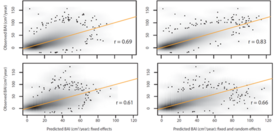
Empirical forest scenario models are used in several contexts, e.g. to evaluate management strategies, to predict potential timber supply, or to estimate carbon sequestration. As key parts of such models, the growth functions are supposed to incorporate a large variety of influencing factors while representing large spatial extents. In recent times, the demand to include effects of climate change into scenario models has increased. Thus, the present study aimed at empirically modelling effects of climate and N-deposition on tree growth, while simultaneously considering effects of stand, management and site properties. Nonlinear mixed-effects models with covariates were fitted to individual-tree basal area increment (BAI) data from the Swiss National Forest Inventory. Data from 1983-2006 were used for model fitting, data from 2009-2013 for model evaluation. A total of 23 potential explanatory variables were included into a variable selection procedure that was performed separately for spruce, fir, pine, larch, further conifers, beech, oak, ash/maple, and further broadleaves. The combinations of selected variables differed among the species, well reflecting their physiological properties. In general, BAI was positively related to DBH, and negatively related to slope, basal area of larger trees, stand density (not so for the shade tolerant beech), mean DBH of the 100 thickest trees per ha, and soil pH. For most species, a positive harvesting effect was identified. Increasing N-deposition resulted in increasing BAI, except for spruce and fir, for which the models indicated an inverse effect. Drought proved to be relevant for most species, except for pine and oak. As a next step, the developed growth functions may be incorporated in empirical forest scenario models and used for nationwide scenario analyses as well as for applications in other parts of central Europe represented in Switzerland’s large environmental gradients.
For more Information see: Rohner, B.; Waldner, P.; Lischke, H.; Ferretti, M.; Thürig, E., 2018: Predicting individual-tree growth of central European tree species as a function of site, stand, management, nutrient, and climate effects. European Journal of Forest Research, 137: 29-44. http://doi.org/10.1007/s10342-017-1087-7
Marco Mina - The Swiss-SpeMixMod project: studying mixing effects using forest inventory data
Mixing effects for any given tree species are difficult to generalize because they can vary greatly along gradients of climatic conditions and resource availability. Identifying the conditions where species diversity can positively influence productivity is crucial but to date few studies have examined how complementarity (i.e., competition, facilitation or competitive reduction) across species and mixture types is modulated by stand and environmental factors. Using the Swiss National Forest Inventory and the climate-sensitive functions developed for the forest scenario model Massimo, we investigated how complementarity for several major central European tree species change with climate, edaphic conditions, stand structural characteristics and species composition. Complementarity varied strongly with stand density and stand development as well as with topographic, climatic and soil conditions. This emphasizes the need to account for site-dependent conditions when exploring mixture effects in relation to forest productivity along gradients. We also found that under certain conditions (i.e., increasing drought and temperature) mixed forests can promote individual-tree growth. Careful assessments depending on the species composing the stands are required under changing resource availability as well as under different levels of stand density and development. These outcomes are of high interest in the context of forest management and conservation, as they allow to identify under which set of conditions promoting species diversity can also help in fostering forest productivity.
For more Information see: Mina, M.; Huber, M.O.; Forrester, D.I.; Thürig, E.; Rohner, B., 2018: Multiple factors modulate tree growth complementarity in Central European mixed forests. Journal of Ecology, 106: 1106-1119. http://doi.org/10.1111/1365-2745.12846
David Forrester - Tree allometric relationships for structurally and species diverse forests
Allometric relationships are often required in forest growth models and to quantify the effects of biodiversity or stand structural characteristics on forest growth and functioning. However, many of the available relationships were developed in monocultures, or they are general relationships developed after combining data from different treatments. This can lead to severely biased predictions and conclusions. The aim of this study was to examine how commonly used relationships between stem diameter and biomass (e.g. foliage, stem or root), height or crown dimensions are modified by vertical structure (dominance), stand density or species composition. The analysis included a meta-analysis of nearly 1000 published biomass equations for major European tree species. All stand structural variables significantly influenced the relationships, but their effects differed widely between the target species. The inter-specific variability was often correlated with species traits (wood density, shade tolerance). With this information, single "general" equations were developed for each given species that could be applied to stands with a wide range of stand structures and species combinations. This approach could improve predictions of biomass and carbon stocks in structurally and compositionally diverse forests.
For more Information see: Forrester, D. I.; Tachauer, I. H. H.; Annighoefer, P.; Barbeito, I.; Pretzsch, H.; Ruiz-Peinado, R.; ... Sileshi, G. W., 2017: Generalized biomass and leaf area allometric equations for European tree species incorporating stand structure, tree age and climate. Forest Ecology and Management, 396, 160-175. http://doi.org/10.1016/j.foreco.2017.04.011
Forrester, D. I.; Benneter, A.; Bouriaud, O.; Bauhus, J., 2016: Diversity and competition influence tree allometric relationships - developing functions for mixed‐species forests. Journal of Ecology, 105, 761-774. https://doi.org/10.1111/1365-2745.12704
